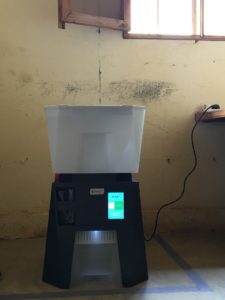October 14, 2019
By: Adam Drolet and Laura Kallen, PATH
Primum non nocere. First, do no harm.
This phrase, espoused in the Hippocratic Oath, serves as the bedrock for the provision of medical care. Yet, for too many individuals and families who visit health care facilities, this tenet may not hold true. Roughly one in seven patients in low- and middle-income countries will develop an infection following admission to a facility. These infections not only have a significant impact on patient morbidity and mortality, but also lead to significant cost burdens for patients and the health system.
Safe water, sanitation, and hygiene (WASH) is recognized as a cornerstone for the provision of quality health care services and infection prevention and control. Yet clear gaps exist regarding WASH services and infrastructure in health care facilities. Globally, roughly 26% of health care facilities lack access to safe water services. An estimated 21% of health care facilities lack any type of sanitation service, and 16% lack any type of hand hygiene service. These gaps increase the potential for the spread of pathogenic organisms via direct patient-provider contact and contact with environmental surfaces. Without interrupting the transmission of bacteria, leading causes of maternal and neonatal death (e.g., sepsis), fecal-oral transmitted diseases (e.g., typhoid and diarrheal diseases), and the rise of multidrug-resistant bacteria will continue.
Fortunately, momentum for addressing gaps in WASH services in health care facilities (HCF) is growing. On May 25, 2019, the World Health Assembly unanimously approved a WASH in HCF resolution calling on member states to prioritize and commit to improving WASH services in HCF. National governments have committed to improvements related to building workforce capacity, developing standards, and allocating funds. Global researchers have generated and proposed actionable approaches to overcoming gaps, as exemplified in a research summary published by the Global Handwashing Partnership, focused on ‘clean hands for all.’ In parallel, leading multilateral institutions such as the World Health Organization have published strategies for implementing multimodal hand hygiene programs to stem the spread of infections. When combined with multifaceted infection prevention and control policies and practices, these programs have successfully reduced rates of hospital-acquired infections.

The MSR SafiStation Chlorine Generator uses just salt, water, and electricity to generate chlorine for water treatment and infection prevention and control. PATH
PATH and MSR Global Health are contributing to improved infection prevention and control activities in HCF by advancing an innovation called the MSR SafiStation™ Chlorine Generator. The device is an easy-to-use chlorine generator designed for low-resource settings. It uses salt, water, and electricity to produce a 1% chlorine solution for infection prevention and control and drinking water treatment. PATH is currently evaluating the effect of the device on environmental hygiene in labor wards in Kenya, as well as working to introduce and scale the device in Ghana and Uganda. In Kenya, SafiStation-generated chlorine will be used for drinking water treatment, treatment of handwashing solution, and surface and equipment disinfection. The hypothesis is that the introduction and use of the SafiStation and its chlorine will result in cleaner environments for patients—in particular, mothers and newborns—and ultimately reduce hospital-acquired infections. In Ghana and Uganda, the SafiStation will be positioned for integration and rollout in national HCF across the two countries.
In addition to WASH approaches, additional prevention strategies are often needed. For example, in communities with limited sanitation infrastructure that are vulnerable to typhoid, vaccinating children with typhoid conjugate vaccine (TCV) provides a crucial complementary approach to stemming the spread of typhoid through WASH measures. Vaccines against cholera, rotavirus, and other fecal-oral pathogens play similarly important roles. Additionally, in the case of infection, facilities should ensure availability and proper use of appropriate antibiotics and other treatment measures.
Infection can come from many angles. Comprehensive, multimodal strategies effectively address the numerous transmission routes of disease-causing pathogens. Approaches range from individual tools, such as ensuring each hospital ward has a handwashing station with soap and clean water or introducing a vaccine, to integrated, multilayered programs that intertwine leadership capacity building, disease surveillance, next-generation WASH technologies, and vaccines. Regardless of the approach, the goal remains the same: ensuring children and their families are protected through multiple interventions—including health care facilities equipped to provide safe, quality health care, adequate WASH, and equitable access to vaccines—in order to safeguard health for all.
Subscribe to our mailing list to receive regular updates from the Global Handwashing Partnership or follow us on social media.
© 2017 The Global Handwashing Partnership (GHP).